ECU Citroen DS5 HYBRID4 RHD 2014 1.G Owner's Manual
[x] Cancel search | Manufacturer: CITROEN, Model Year: 2014, Model line: DS5 HYBRID4 RHD, Model: Citroen DS5 HYBRID4 RHD 2014 1.GPages: 382, PDF Size: 14.52 MB
Page 93 of 382

91Access
Central locking control
Automatic central locking of the doors
(anti-intrusion security)
The doors and boot can lock automatically while driving (speed above 6 mph (10 km/h)). To activate or deactivate this function (activated by default):
If the vehicle is deadlocked or locked from the outside, the button is not active. In this case, use the remote control to unlock the vehicle or pull an interior door handle to open a door. If one of the doors is open, central locking from the inside does not take
place.
Driving with the doors locked may make access to the passenger compartment by the emergency services more difficult in an emergency.
System allowing the doors to be locked and unlocked manually in the event of a malfunction of the central locking system or battery failure.
Emergency control
Operate the button. This allows the doors and the boot to be locked or unlocked.
Operate this button until a message appears in the instrument panel screen.
Transporting long or voluminous objects If you want to drive with the boot open, press the central locking control button to lock the doors.
Locking the driver's door
Insert the key in the door lock, then turn it to the rear. You can also apply the procedure described for the passenger doors.
Unlocking the driver's door
Insert the key in the door lock, then turn it to the front.
Page 114 of 382
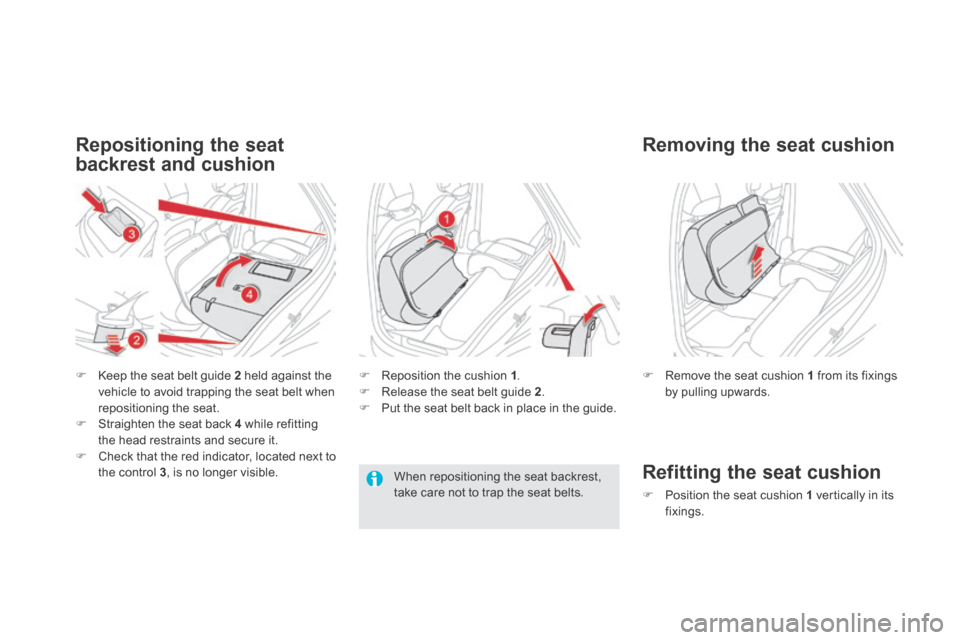
Repositioning the seat
backrest and cushion
Keep the seat belt guide 2 held against the vehicle to avoid trapping the seat belt when repositioning the seat. Straighten the seat back 4 while refitting the head restraints and secure it. Check that the red indicator, located next to the control 3 , is no longer visible.
Reposition the cushion 1 . Release the seat belt guide 2 . Put the seat belt back in place in the guide.
When repositioning the seat backrest, take care not to trap the seat belts.
Remove the seat cushion 1 from its fixings by pulling upwards.
Removing the seat cushion
Refitting the seat cushion
Position the seat cushion 1 vertically in its fixings.
Page 119 of 382

11 7Comfort
Mats Removable carpet protection.
move the seat fully back, fit the mat in place, engage the fixings by pressing down on them.
Fitting
Removal
To remove the mat on the driver's side: move the seat fully back, disengage the fixings, leaving the fixing pins in the floor carpet, remove the mat.
Refitting
To refit the mat on the driver's side: position the mat correctly, refit the fixings by pressing, check that the mat is secured correctly.
To avoid any risk of jamming of the pedals: - only use mats which are suited to the fixings already present in the vehicle; these fixings must be used, - never fit one mat on top of another. The use of mats not approved by
CITROËN may inter fere with access to the pedals and hinder the operation of the cruise control / speed limiter.
To use the cigarette lighter, press it in and wait a few seconds until it pops out automatically. To connect a 12 V accessory (max power: 120 W), remove the cigarette lighter and connect a suitable adaptor. You can use this socket to connect a telephone charger, a bottle warmer... After use, put the cigarette lighter back into
place straight away.
Cigarette lighter /
12 V accessory
socket
Page 188 of 382

Group 0+: from bir th to 13 kg
L1 "RÖMER Baby-Safe Plus" Installed in the rear ward facing position.
Groups 2 and 3: from 15 to 36 kg
L4 "KLIPPAN Optima"
From 22 kg (approximately 6 years), the booster is used on its own.
L5 "RÖMER KIDFIX" Can be fitted to the vehicle's ISOFIX mountings. The child is restrained by the seat belt.
Child seats recommended by CITROËN
CITROËN offers a complete range of recommended child seats which are secured using a three point seat belt .
Page 189 of 382
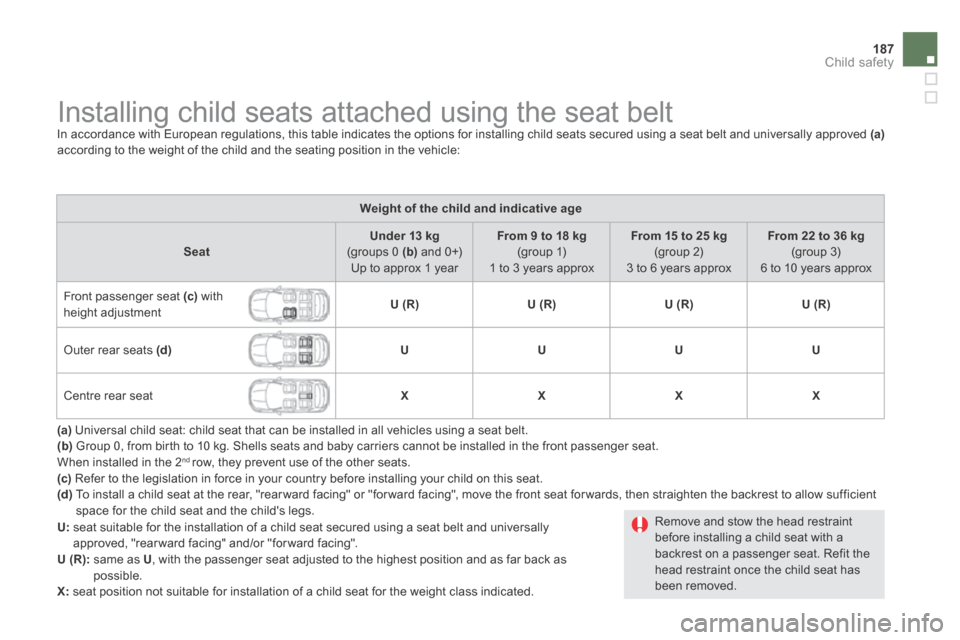
187Child safety
Installing child seats attached using the seat belt In accordance with European regulations, this table indicates the options for installing child seats secured using a seat belt and universally approved (a)according to the weight of the child and the seating position in the vehicle:
Weight of the child and indicative age
SeatUnder 13 kg (groups 0 ( b ) and 0+) Up to approx 1 year
From 9 to 18 kg (group 1) 1 to 3 years approx
From 15 to 25 kg (group 2) 3 to 6 years approx
From 22 to 36 kg (group 3) 6 to 10 years approx
Front passenger seat ( c ) with height adjustment U (R)U (R)U (R)U (R)
Outer rear seats (d) UUUU
Centre rear seat XXXX
(a) Universal child seat: child seat that can be installed in all vehicles using a seat belt. (b) Group 0, from birth to 10 kg. Shells seats and baby carriers cannot be installed in the front passenger seat .When installed in the 2 nd row, they prevent use of the other seats .(c) Refer to the legislation in force in your country before installing your child on this seat. (d) To install a child seat at the rear, "rear ward facing" or "for ward facing", move the front seat for wards, then straighten the backrest to allow sufficient space for the child seat and the child's legs. Remove and stow the head restraint before installing a child seat with a backrest on a passenger seat. Refit the head restraint once the child seat has
been removed.
U: seat suitable for the installation of a child seat secured using a seat belt and universally approved, "rearward facing" and/or "forward facing". U (R): same as U , with the passenger seat adjusted to the highest position and as far back as possible. X: seat position not suitable for installation of a child seat for the weight class indicated.
Page 190 of 382
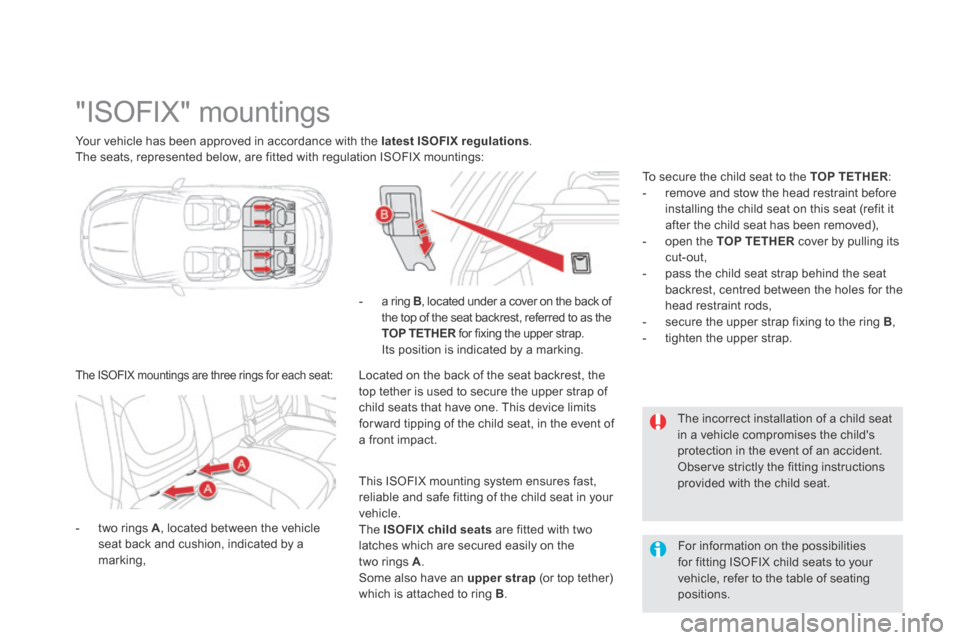
Your vehicle has been approved in accordance with the latest ISOFIX regulations . The seats, represented below, are fitted with regulation ISOFIX mountings:
"ISOFIX" mountings
The ISOFIX mountings are three rings for each seat:
To secure the child seat to the TOP TETHER : - remove and stow the head restraint before installing the child seat on this seat (refit it after the child seat has been removed), - open the TOP TETHER cover by pulling its cut-out, - pass the child seat strap behind the seat backrest, centred between the holes for the head restraint rods, - secure the upper strap fixing to the ring B , - tighten the upper strap.
The incorrect installation of a child seat
in a vehicle compromises the child's protection in the event of an accident. Observe strictly the fitting instructions provided with the child seat.
For information on the possibilities for fitting ISOFIX child seats to your vehicle, refer to the table of seating positions.
- a ring B , located under a cover on the back of the top of the seat backrest, referred to as the TOP TETHER for fixing the upper strap. TOP TETHER for fixing the upper strap. TOP TETHER Its position is indicated by a marking.
- two rings A , located between the vehicle seat back and cushion, indicated by a marking,
This ISOFIX mounting system ensures fast, reliable and safe fitting of the child seat in your vehicle. The ISOFIX child seats are fitted with two latches which are secured easily on the two rings A . Some also have an upper strap (or top tether) which is attached to ring B .
Located on the back of the seat backrest, the top tether is used to secure the upper strap of child seats that have one. This device limits for ward tipping of the child seat, in the event of a front impact.
Page 191 of 382
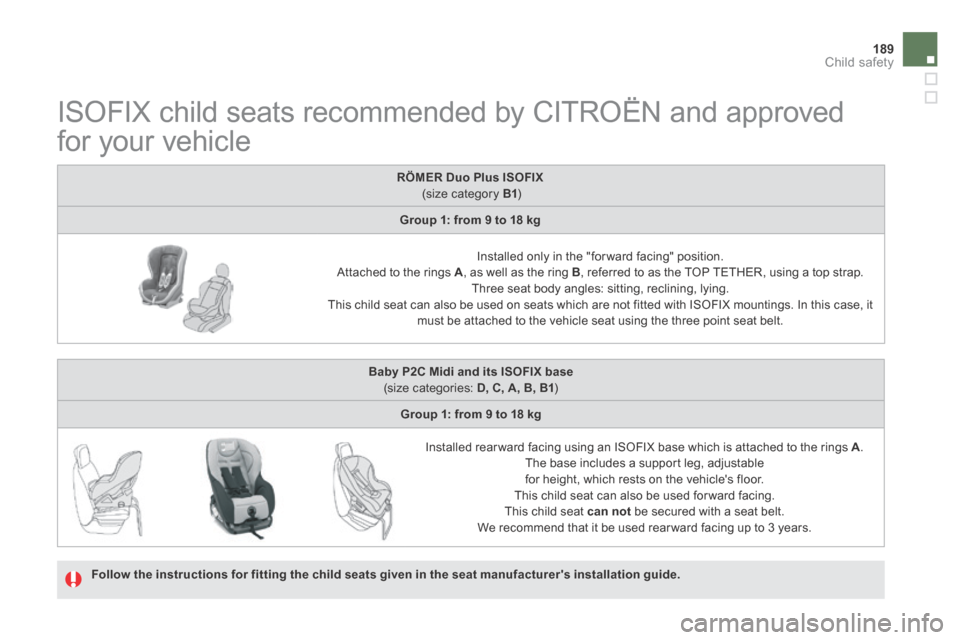
189Child safety
ISOFIX child seats recommended by CITROËN and approved
for your vehicle
Follow the instructions for fitting the child seats given in the seat manufacturer's installation guide.
RÖMER Duo Plus ISOFIX (size category B1 )
Group 1: from 9 to 18 kg
Installed only in the "for ward facing" position. Attached to the rings A , as well as the ring B , referred to as the TOP TETHER, using a top strap. Three seat body angles: sitting, reclining, lying. This child seat can also be used on seats which are not fitted with ISOFIX mountings. In this case, it must be attached to the vehicle seat using the three point seat belt.
Baby P2C Midi and its ISOFIX base (size categories: D, C, A, B, B1 )
Group 1: from 9 to 18 kg
Installed rear ward facing using an ISOFIX base which is attached to the rings A . The base includes a support leg, adjustable for height, which rests on the vehicle's floor. This child seat can also be used for ward facing. This child seat can not be secured with a seat belt. We recommend that it be used rear ward facing up to 3 years.
Page 193 of 382
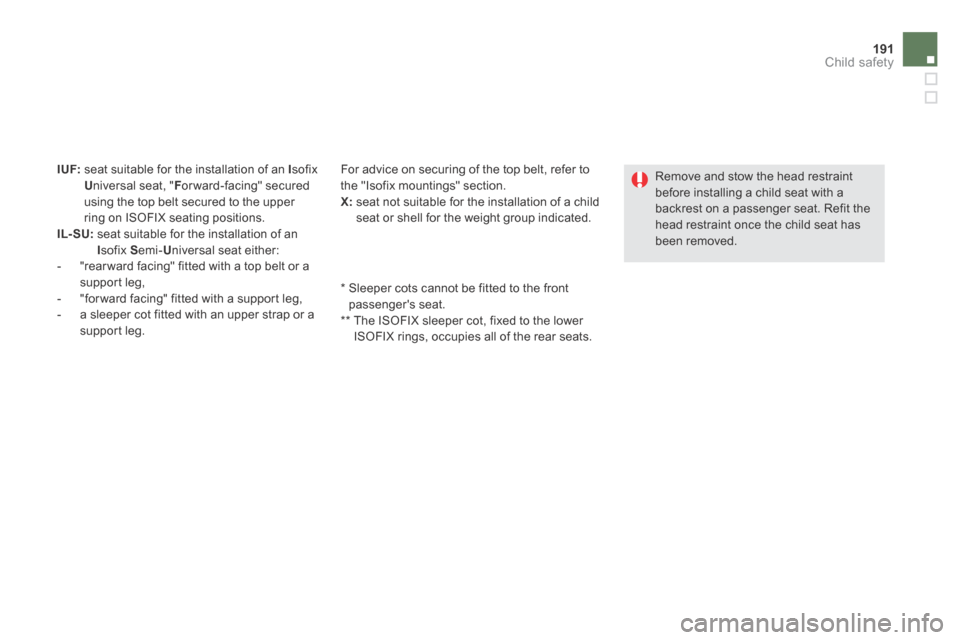
191Child safety
I UF: seat suitable for the installation of an I sofix U niversal seat, " F or ward-facing" secured using the top belt secured to the upper ring on ISOFIX seating positions.
IL- SU: seat suitable for the installation of an I sofix S emi- U niversal seat either: - "rear ward facing" fitted with a top belt or a support leg, - "for ward facing" fitted with a support leg, - a sleeper cot fitted with an upper strap or a support leg.
* Sleeper cots cannot be fitted to the front passenger's seat. ** The ISOFIX sleeper cot, fixed to the lower ISOFIX rings, occupies all of the rear seats.
Remove and stow the head restraint before installing a child seat with a backrest on a passenger seat. Refit the head restraint once the child seat has been removed.
For advice on securing of the top belt, refer to the "Isofix mountings" section. X: seat not suitable for the installation of a child seat or shell for the weight group indicated.
Page 194 of 382
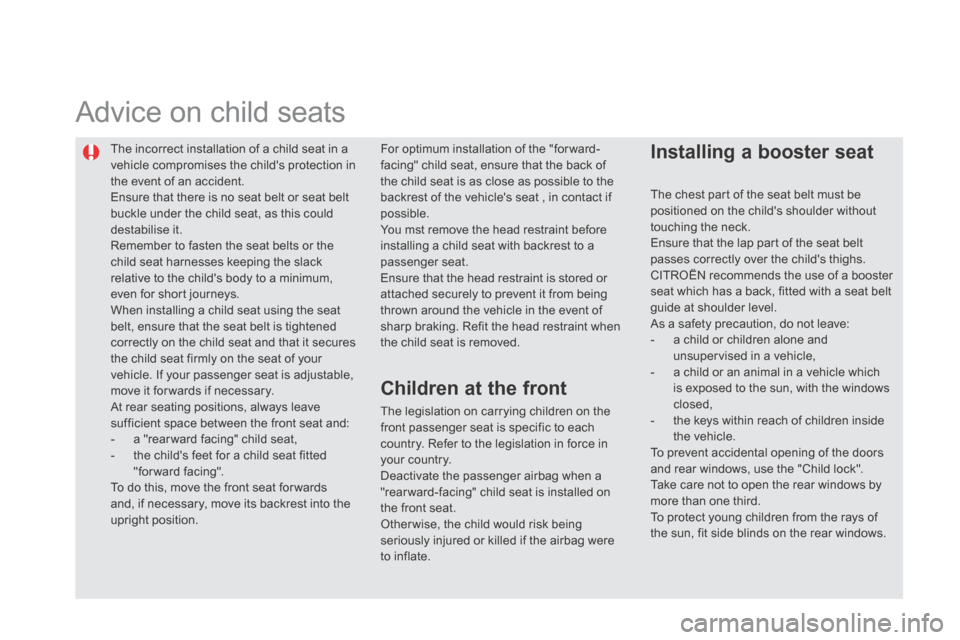
The incorrect installation of a child seat in a vehicle compromises the child's protection in the event of an accident. Ensure that there is no seat belt or seat belt buckle under the child seat, as this could
destabilise it. Remember to fasten the seat belts or the child seat harnesses keeping the slack relative to the child's body to a minimum, even for short journeys. When installing a child seat using the seat belt, ensure that the seat belt is tightened correctly on the child seat and that it secures the child seat firmly on the seat of your vehicle. If your passenger seat is adjustable, move it for wards if necessary. At rear seating positions, always leave sufficient space between the front seat and: - a "rear ward facing" child seat, - the child's feet for a child seat fitted "forward facing". To do this, move the front seat for wards and, if necessary, move its backrest into the upright position.
Advice on child seats
Installing a booster seat
The chest part of the seat belt must be positioned on the child's shoulder without
touching the neck. Ensure that the lap part of the seat belt passes correctly over the child's thighs. CITROËN recommends the use of a booster seat which has a back, fitted with a seat belt guide at shoulder level. As a safety precaution, do not leave: - a child or children alone and unsupervised in a vehicle, - a child or an animal in a vehicle which is exposed to the sun, with the windows closed, - the keys within reach of children inside the vehicle. To prevent accidental opening of the doors and rear windows, use the "Child lock". Take care not to open the rear windows by more than one third. To protect young children from the rays of the sun, fit side blinds on the rear windows.
The legislation on carrying children on the front passenger seat is specific to each country. Refer to the legislation in force in your country. Deactivate the passenger airbag when a "rear ward-facing" child seat is installed on the front seat. Otherwise, the child would risk being seriously injured or killed if the airbag were to inflate.
Children at the front
For optimum installation of the "forward-facing" child seat, ensure that the back of the child seat is as close as possible to the backrest of the vehicle's seat , in contact if possible.
You mst remove the head restraint before installing a child seat with backrest to a passenger seat. Ensure that the head restraint is stored or attached securely to prevent it from being thrown around the vehicle in the event of sharp braking. Refit the head restraint when the child seat is removed.
Page 206 of 382
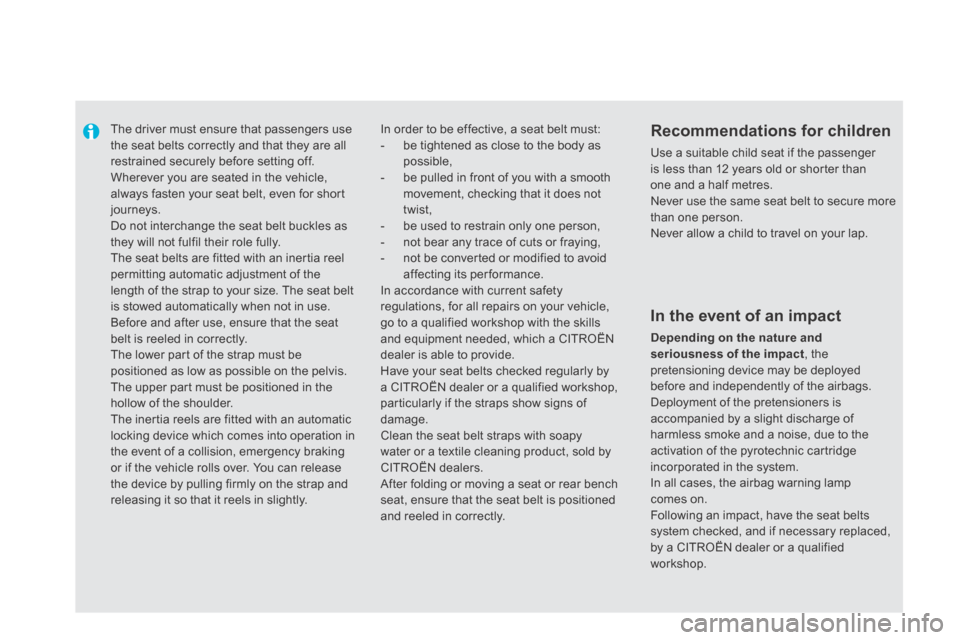
The driver must ensure that passengers use the seat belts correctly and that they are all restrained securely before setting off. Wherever you are seated in the vehicle, always fasten your seat belt, even for short journeys. Do not interchange the seat belt buckles as they will not fulfil their role fully. The seat belts are fitted with an inertia reel permitting automatic adjustment of the length of the strap to your size. The seat belt is stowed automatically when not in use. Before and after use, ensure that the seat belt is reeled in correctly. The lower part of the strap must be positioned as low as possible on the pelvis. The upper part must be positioned in the hollow of the shoulder. The inertia reels are fitted with an automatic locking device which comes into operation in the event of a collision, emergency braking or if the vehicle rolls over. You can release the device by pulling firmly on the strap and releasing it so that it reels in slightly.
Recommendations for children
Use a suitable child seat if the passenger is less than 12 years old or shorter than one and a half metres. Never use the same seat belt to secure more than one person. Never allow a child to travel on your lap.
In order to be effective, a seat belt must: - be tightened as close to the body as possible, - be pulled in front of you with a smooth movement, checking that it does not twist, - be used to restrain only one person, - not bear any trace of cuts or fraying, - not be converted or modified to avoid affecting its performance. In accordance with current safety regulations, for all repairs on your vehicle, go to a qualified workshop with the skills and equipment needed, which a CITROËN dealer is able to provide. Have your seat belts checked regularly by a CITROËN dealer or a qualified workshop, particularly if the straps show signs of damage. Clean the seat belt straps with soapy water or a textile cleaning product, sold by CITROËN dealers. After folding or moving a seat or rear bench seat, ensure that the seat belt is positioned and reeled in correctly.
In the event of an impact
Depending on the nature and seriousness of the impact , the pretensioning device may be deployed before and independently of the airbags. Deployment of the pretensioners is accompanied by a slight discharge of harmless smoke and a noise, due to the activation of the pyrotechnic cartridge incorporated in the system. In all cases, the airbag warning lamp comes on. Following an impact, have the seat belts system checked, and if necessary replaced, by a CITROËN dealer or a qualified workshop.